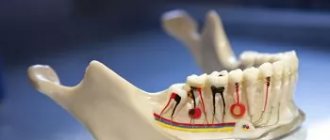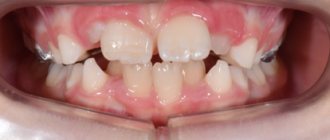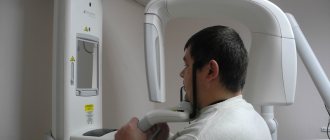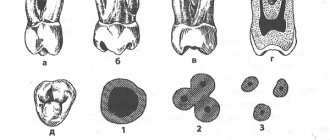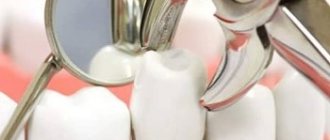7687
According to studies, the incidence of mesial occlusion with cross occlusion in children during primary and mixed dentition reaches 10-12%.
The anomaly is characterized by a narrowed upper jaw, narrow nasal passages, violation of proper occlusion, difficulty biting and chewing food and some other negative consequences.
Failure to correct a narrowed jaw can lead to disruption of the symmetry of the child’s face, pathological restructuring of the masticatory muscles, and disruption of the TMJ.
The most effective means of treating the anomaly are devices for palatal expansion. One such device, specifically adapted for use in children in mixed dentition, is the Marco Ross palatal expander.
General overview
The full name of the Ross apparatus is plate-type, non-removable, mechanically operating, single-jaw. The device consists of the following elements:
- Hyrex screw with guides on both sides. Serves to create an expanding force.
- Rings for temporary molars. Provide fixation of the device on the supporting teeth.
- Metal feet. They rest against temporary fangs, creating points of application of force to the dentition, additional to the rings.
- Plastic base (plate), consisting of two parts. Combines all components into a single design.
The device bears the name of its developer. It is made from a plaster model, molded according to an impression from the child’s upper jaw. Costs about 10,000 rubles.
The use of the device allows you to expand the upper jaw along the median seam by 10-13 mm, increase the length of the upper jaw arch, eliminate mesial occlusion, and achieve normalization of a number of other functions of the dentofacial apparatus in children aged 5-11 years.
Depending on the tasks being solved, the Ross apparatus can be modified, in particular, equipped with dental onlays.
Anomaly classification
Using the device, you can solve the following types of anomalies:
- compression of the dentition along the entire length with advancement of the anterior section;
- uneven development with asymmetry;
- narrowing of the anterior sector;
- compression of the jaw with a saddle-shaped jaw;
- trapezoidal jaw shape.
Length compression is characterized by a strong protrusion of the front part of the row relative to the lateral sections. As a result, the incisors begin to grow close to the frontal part, and the front teeth grow in a fan-shaped manner.
Narrowing of only the frontal part with the appearance of a V-shaped area. The incisors begin to grow incorrectly, an acute angle is formed, and over time, chips and other defects appear.
The development is uneven, there is asymmetry in the series. Narrowing is observed only in certain areas, crowding appears.
Row compression is a pathology that develops in the area of premolars and molars. The shape of the jaw becomes saddle-shaped, and the pathology gradually covers the entire row.
With a trapezoidal jaw shape, the row takes on a rectangular shape, the corners are clearly visible, and the incisors become crowded. Often there is a turn around the axis, incorrect growth.
Indications for use
The optimal time to use the device is 6-8 years. However, depending on the clinical picture, this interval can be extended to 5-11 years.
Indications for the use of the Marco Ross apparatus are many pathological changes in the dentofacial apparatus caused by a narrow upper jaw:
- Cross mesial bite.
- Lack of space for permanent teeth in the anterior segment of the upper jaw. Lack of space causes permanent teeth to shift relative to the dental arch, either palatally (usually) or vestibularly, when they erupt.
- Speech impairment due to limited tongue movement.
- Mouth breathing due to narrow nasal passages.
- Excessive development of the lower jaw and its blocking by the upper teeth.
- Problems with biting and chewing food.
- Lack of physiological abrasion of primary canines, preventing correct occlusion.
- TMJ dysfunction due to mesial crossbite. Its signal can be headaches that are otherwise unexplained.
What devices does Nord's device belong to by purpose?
Visit here to view popular preventive orthodontic appliances.
At this address https://orto-info.ru/sistemyi-vyiravnivaniya-zubov/lechebno-profilakticheskie-apparatyi/vse-sekretyi-fnta.html all the most important things about the functional fixed telescopic device.
Operating principle of the device
The principle of operation of the Marco Ross apparatus does not differ from other devices used to expand the upper jaw along the median palatal suture.
The expansion force is created by the Hyrex screw. Its rotation causes expansion of the plastic base, which transmits the force from the screw to the dentition using rings and legs. The first ones are put on the primary molars, the second ones rest on the primary canines.
It takes several days to manufacture the device. Getting used to it takes about the same amount of time, during which diction may become impaired. After getting used to it, it recovers.
A special feature of the device is that the plastic base does not put pressure on the palate and alveolar processes, but only lightly touches them. This makes wearing the device more comfortable.
The device is practically invisible, due to the fact that the legs resting on the fangs are attached with a composite and not with rings.
The device is activated using a special key with a pin. The central part of the screw has holes located at an angle of 90°. The key is inserted with its pin into the hole and turned a quarter turn. One turn corresponds to moving the base plate screw by 0.25 mm.
The main subtlety of activation is that at the end of each turn of the key, the next hole appears where a pin can be inserted.
Activation is performed by the baby’s parents daily or at intervals of several days - in accordance with the scheme specified by the orthodontist.
You can use fast and slow expansion. Fast involves activating the screw every day, slow - after a few days.
It is believed that slow expansion provides a more stable result, however, it takes longer. Some experts recommend a combination of fast and slow expansion. For example, at the beginning of treatment, a slow expansion is carried out, and after a few weeks - a rapid one.
When using forced expansion, the active treatment period lasts about a month. In the next 0.5-1 year, the device is worn for retention purposes without activation.
Although the Marco Ross device does not directly affect the lower jaw, it does have an indirect effect. Normalizing the parameters of the upper jaw leads to the unlocking of the lower jaw and its adjustment to the upper one.
When wearing the device, special attention is paid to oral hygiene, more precisely, to the place of contact of the base plate with the palate , where food can be stuffed. It is best to clean it with an irrigator.
Devices supported by microimplants
With the advent of new technologies in orthodontics, expanders based on microimplants have been developed. The devices serve as an excellent alternative to traditional expanders and are also effective in combination with braces. They are successfully used for selective (targeted) movement of teeth. In daily practice, we use innovative devices to expand the arch of the upper jaw:
- MARPE (micro-implant assisted rapid palatal expander (MARPE)
- SARPE (surgically assisted rapid palatal expansion (SARPE)
Mini-screws are screwed into any bone of the oral cavity, do not require a period of osseointegration and can withstand force loads well. Provide predictability of orthodontic treatment and maximum skeletal effect.
Installation process
The Marco Rosa apparatus has four elements that are used to fix it to the jaw. Two rings (left and right) that fit on the molars, and two legs (also left and right) that rest on the fangs.
Installation is performed in the following sequence:
- A week before installing the device, separating rubber bands (separation rings) are inserted between the supporting painter and adjacent teeth, which create a gap for installing metal rings on the painters. On the day of installation of the plates, these elements are removed before the start of the procedure.
- All teeth are cleaned with a rotating brush and toothpaste.
- Prepared cement is applied to the rings of the apparatus.
- The device is inserted into the mouth, the rings are put on the molars and pressed all the way with the instrument. The paws should be located on the occlusal surface of the canines. Excess cement is removed.
- The interdental spaces in the area where the rings are fixed are cleaned with thread.
- A composite is applied to the fangs at the point of their contact with the paws to fix the paws. Excess composite is removed.
- The junction is irradiated with light (to polymerize the composite).
This completes the installation of the plate..
In the video, watch how the Marco Ross apparatus is installed.
Features of treatment
Usually a narrowed jaw is combined with other dental anomalies and disorders - excessive development of the lower jaw, mouth breathing, pronunciation defects. Therefore, treatment with a Ross device can be especially effective in complex treatment.
In particular, in addition to the device it is desirable:
- the use of a face mask - an extra-oral structure, which, thanks to the chin pad, stops the development of the lower jaw;
- with mouth breathing, it is advisable to participate in the treatment of an ENT doctor. He must monitor the process of normalization of breathing;
- Correction of speech and swallowing is recommended with the participation of a speech therapist and myofunctional therapist. Their task is to normalize the tone of the facial and chewing muscles, correct the pressure of the tongue on the teeth, and control swallowing.
Only with such joint efforts can we ensure correction of all the adverse consequences of a narrowed jaw.
Will braces be needed?
Before starting treatment with the Marco Ross apparatus, it is impossible to say for sure whether further treatment with braces will be needed or not. This depends on the results of correction of disorders and the direction of development of the child’s dental apparatus.
In some cases, if the anomaly is not completely eliminated, braces will be required. In other circumstances, when the violations are completely eliminated, such a need does not arise.
But even if braces are used, treatment with them after correction with the Marco Ross apparatus will be much faster and easier than without it.
In addition, refusal to treat a narrowed upper jaw in childhood can create a situation in which an adult with fully formed teeth will need surgical intervention and the cost of the issue will be many times higher. If possible, it is better to avoid this.
What does the Bruxogard trainer look like and what is its purpose?
This publication provides instructions for using the TMJ joint splint.
Here https://orto-info.ru/sistemyi-vyiravnivaniya-zubov/lechebno-profilakticheskie-apparatyi/ispolzovanie-bidermana.html all the most important things about the Biderman apparatus.
Our advantages in orthodontic dentistry
- A wide range of treatment methods providing correction of bite pathology of any complexity.
- Application of innovative technologies, practical use of the best world experience.
- Experienced orthodontists working to strict international standards.
- Cooperation with foreign laboratories to create your ideal smile (California, USA).
- Lasting treatment results.
- Convenient clinic location and work schedule, 24-hour appointments, impeccable service and comfortable service.
All the pros and cons of the technique
The Marco Ross device demonstrates almost one hundred percent successful results due to a number of features:
- High efficiency due to the fact that expansion occurs along the unfused median palatal suture.
- Complexity of impact. Along with the expansion of the jaw, the symmetry and aesthetics of the face are restored, the nasal passages are expanded (nasal breathing becomes easier), speech and swallowing are normalized, and mesial occlusion is eliminated.
- Short wearing period when using rapid expansion.
- Inconspicuous when worn.
- Elimination of treatment with braces or, in extreme cases, its significant relief.
- Easy ability to set the expansion rate (the screw can be turned to a larger or smaller angle, daily or intermittently).
- Possibility of use in primary and mixed dentition , when the correction of any dental anomalies is most effective.
- Simplicity and elegance of the design , bright color of the base plates, attractive to the child (creates motivation and eliminates the baby’s anxiety).
The only disadvantages include discomfort after activation and the need for long-term retention. But these features are characteristic of all orthodontic devices without exception.
Patient reviews
- Adikina Lyubov
We would like to express our deep gratitude to Sofya Sergeevna. My daughter and I went to see her to have her teeth treated and her bite straightened. Very responsive, attentive and caring. The child is very happy, the parents are even more so)) thank you for your good and sensitive attitude towards each patient! And the plates really helped to straighten both the bite and the teeth. Burkova Ekaterina Alekseevna
The Estetika clinic has very attentive staff and top-level service. Special thanks to Sofya Sergeevna for her excellent attitude towards patients and attentive approach to everyone. Well done. Growth and advancement to you.
Maksimova Maria Ivanovna
I was pleased with the price/quality ratio, professionalism and individual approach. Thank you for your human attitude, energy, purity and joy. I really wanted to come here again and bring, entrust into your hands Sofya Sergeevna, all my dearest, dearest and closest successes to you!!!
Luneva L.N.
Thank you!!!
Especially for your patience. For an accessible story about problems. Special words of gratitude to Sofya Sergeevna and registrar Olga. Everything is just super!
ALL REVIEWS


